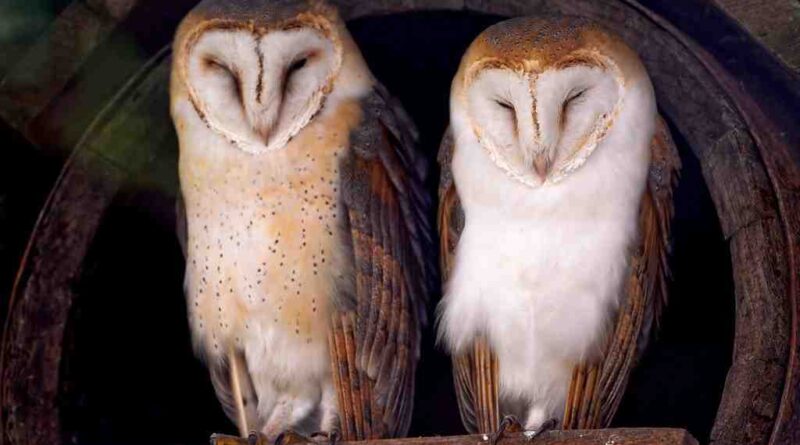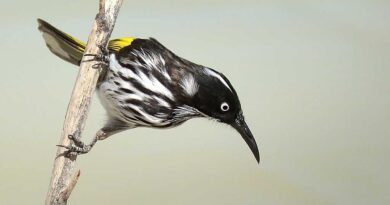OWLS
OWLS, soft-plumaged, short-tailed, big-headed, usually nocturnal, birds of prey They have large eyes directed forward, surrounded by facial discs. The bill is hooked, and the claws are sharp. Owls vary in size, from the sparrow-sized pigmy owl to the huge eagle owl.
When most other birds are roosting, the owl must find food and defend its territory against competitors. The success of owls under these conditions depends on the efficacy of their sense organs, which are adapted to work in the dark. Their vision is estimated to be 35–100 times more sensitive than our own. Their eyes are relatively enormous, with very wide corneas that allow the maximum amount of light to pass through to the retina. The sense of hearing is also extremely well developed, particularly in Barn owls. Their cars, though completely hidden under their feathers, are large and partly covered by flaps of skin. The part of the medulla of the brain concerned with hearing is also well developed, containing 95,000 nerve cells in the Barn owl compared with only 27,000 in a crow twice the weight.
Many owls, including the 6 lb (2–7 kg) Eagle owl, fly with hardly a whisper. Silent flight doubtless helps them to pounce on un-suspecting prey and ensures that their sensitive hearing is not ‘jammed’ by noisy pinions.
Owls are vociferous, and their hoots and screams make up a well-developed language. The majority have low-frequency voices, giving them a human-like quality. Owls need to proclaim their hunting territories and communicate with their mates over large areas, and the carrying power of low-pitched notes is much greater than that of high-pitched or squeaky ones. Hoots then act rather like foghorns, as sound beacons in the darkness.
Owls are basically hole-nesters, laying their eggs in crevices, open cavities, or inside the vacated homes of woodpeckers. A few, like the Snowy Owl Nyctea scandiaca, nest on the ground. Like the eggs of other hole-nesting birds, those of owls are white.
Clutches vary from 1–7 or more, and usually both sexes incubate, and in all cases, both parents feed the young.
The main diet is mice, voles, and rats, and the snowy owl and short-eared owls also take lemmings and hares. Owls usually swallow their prey whole, including the indigestible bones. feathers and fur afterwards being regurgitated as pellets.
There are about 132 species of owls divided into two families, the Barn owls. Tytonidae and the typical owl, Strigidae. Barn owls are characterized by big, hcart-shaped facial discs and long tarsi and by having the middle claws on each foot extended into serrated ‘combs’. They are 13–18 inches (33–45 cm) long, with the females usually being larger than the males. They are not migratory. The common barn owl, Tyto alba, has an almost world-wide range. It is golden-brown above and lighter below, barred with white, black, and grey. It nests in hollow trees or on buildings. It is nocturnal and hunts its prey of rats and mice more by sound than by sight. It is believed that the facial disc has an acoustic function, gathering and concentrating sound waves. It has been demonstrated in recent years that a barn owl can catch living rodents in complete darkness, provided the prey makes some sound.
In the genus Bubo, there are 12 kinds of large eagle owls occurring in the New World and across the Philippines. The Hawk owls Ninox replace the Eagle owls in Australasia, as do the Eared, Scops, and Screech owls Otus, which stretch from the Americas through Eurasia and Africa to the southwest Pacific islands. Lacking ear tufts are the three similar Eurasian little owls, Athene. Tropical genera include the curiously marked Spectral owls Pulsatrix, Wood owls Ciccaba, and the Afro-Asian fishing owls Ketupa and Scotopelia.
The best known are the earless’, chiefly black-eyed wood owls, Strix, most of which
have feathered feet and rounded wings. They are chiefly found in temperate woodlands in the New and Old Worlds, excepting Australia and New Zealand. The Tawny owl Strix aluco is found over most of Europe and parts of Asia and North Africa. It is the owl most often seen in Britain. Also known as the brown owl, it has two color phases, grey and brown.
Six Asio owls are all ‘eared’ and the long- and short-eared owls, A. otus and 4.flammeus, are both widely distributed circumpolar species. The second of these, found even in temperate South America, must be one of the most southerly of all owls. Four members of the genus Aegolius are rather like miniature Strix owls and lack ear tufts. There are three mono-specific strigine genera: the eared Pseudoscops grammicus and Rhinotynx clamator of the Caribbean and South America, respectively, and the non-eared but large fearful owl Nesario solomonensis from the southwest Pacific. ORDER: Strigiformes, CLASS: Aves.
The white-faced scops owl Otus leucotis, a 9-in (22-cm) log, is common in the African bush and also penetrates far into the Sahara and other desert areas. The Oriental hawk owi Ninox scutulata of eastern and southern Asia, 9 in. (22 cm) long, hunts insects in forest edges and in jungles.



